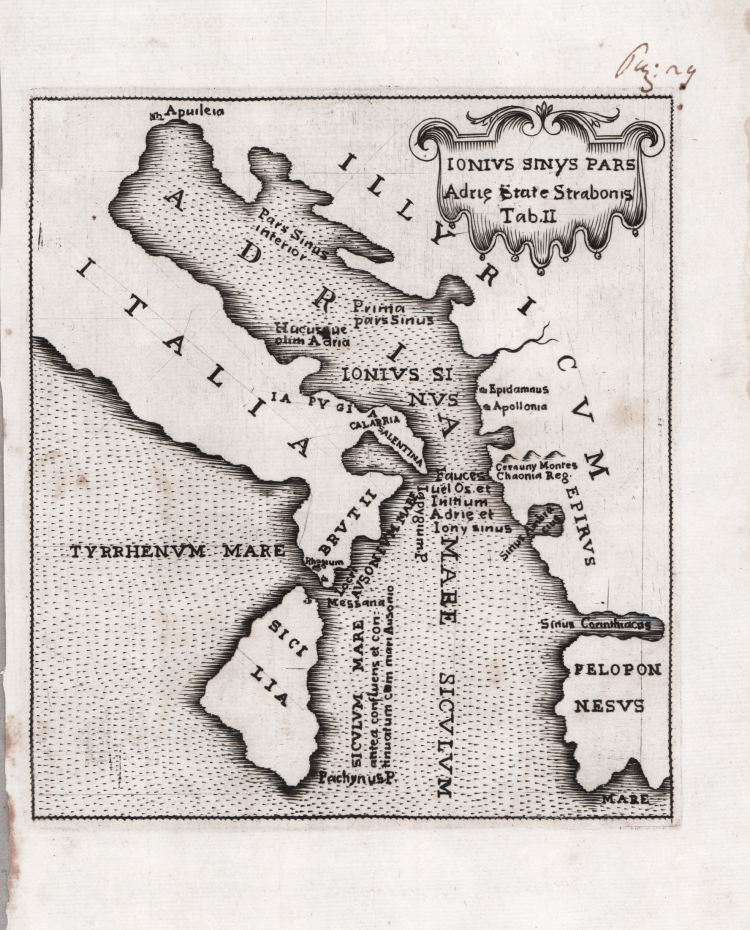



| Reference: | S34985 |
| Author | Ignazio Giorgi [Đurđević] |
| Year: | 1730 |
| Zone: | Eastern Mediterranean Sea |
| Printed: | Venice |
| Measures: | 132 x 152 mm |


| Reference: | S34985 |
| Author | Ignazio Giorgi [Đurđević] |
| Year: | 1730 |
| Zone: | Eastern Mediterranean Sea |
| Printed: | Venice |
| Measures: | 132 x 152 mm |
Etching, printed on contemporary laid paper, with margins, usual folds of paper for the rest in excellent condition.
Taken from: D. Paulus Apostolus in mari quod nunc venetus Sámus dicitur maufragus et Melitae Dalmatensis insulae post naufragium hospes sive de genuino significatu duorum locorum in Actibus Apostolicis 27 27 Navigantibus nobis in Adria et 28 M Tunc cognovimus quod Medita insula vocabatur inspectiones anticriticae auctore D Ignatio Georgi Benedictino e Congregatione Melitensi Ragusina Adjicitur brevis dissertatio ejusdem auctoris de Catellis Melitaeis Venetiis apud Christophorum Zane 1730.
It is a historical plate, linked to the illustration of St. Paul's voyage, reconstructed by Ignazio Giorgi from Ragusa, better known by the Croatian name of Đurđević.
Rare.
Ignazio Giorgi [Đurđević] (1675-1737)
|
Ignjat Đurđević (also Ignazio Giorgi) was a baroque poet and translator from the Republic of Ragusa, best known for his long poem Uzdasi Mandaljene pokornice ("Sighs of Repentant Magdalene"). He wrote poetry in three languages: Latin, Italian and Croatian.
Đurđević was born in Ragusa to Bernardo Giorgi and Teresa Zlatarić. He did not belong to the House of Giorgi, but to a minor, recently ennobled, family, the Giorgi di Bernardo.
As a member of a rich and respectable family, he lived recklessly and often in debauchery. His love adventures cost him the position of the duke on Šipan. Because of his unrequited love towards a diklica (girl) from Dubrovnik and a libertine poem he wrote to her, Đurđević even had to leave the city for a while.
He was a tri-lingual poet (he wrote in Latin, Italian and Croatian) with deep feelings, unrestrained by Catholic morals. His fiery Ljuvene pjesni (Love Poems) are some of the best lyric poems from Dubrovnik, with influences of Bunić's verse. Suze Marunkove (Marunko's Tears), Đurđević's poem about Marunko from the island of Mljet, who is sighing because of a beautiful djevičina (maid) Pavica, were obviously inspired by Derviš, written by his namesake Stijepan Đurđević. Still, Ignjat often manages to surpass Stijepan because of his freer style.
After more than twenty years of preparations, Đurđević printed Uzdasi Mandaljene pokornice ("Sighs of Repentant Magdalene") in Venice in 1728, together with the cycle of Pjesni razlike (Various Poems). Magdalene is his most beautiful work, while Poems have exceptionally varied themes and forms. Experts in Croatian literature like Mihovil Kombol and Ivo Frangeš noticed that the themes and forms of Đurđević's Poems are similar to the poems of Fran Krsto Frankopan.
In 1729, his Saltijer slovinski (Slavic Psalms) were printed in Venice. They contain translations or paraphrases of the psalms of King David. Their fine language and style distinguish them from many similar translations made by the poets of Dubrovnik.
|
Ignazio Giorgi [Đurđević] (1675-1737)
|
Ignjat Đurđević (also Ignazio Giorgi) was a baroque poet and translator from the Republic of Ragusa, best known for his long poem Uzdasi Mandaljene pokornice ("Sighs of Repentant Magdalene"). He wrote poetry in three languages: Latin, Italian and Croatian.
Đurđević was born in Ragusa to Bernardo Giorgi and Teresa Zlatarić. He did not belong to the House of Giorgi, but to a minor, recently ennobled, family, the Giorgi di Bernardo.
As a member of a rich and respectable family, he lived recklessly and often in debauchery. His love adventures cost him the position of the duke on Šipan. Because of his unrequited love towards a diklica (girl) from Dubrovnik and a libertine poem he wrote to her, Đurđević even had to leave the city for a while.
He was a tri-lingual poet (he wrote in Latin, Italian and Croatian) with deep feelings, unrestrained by Catholic morals. His fiery Ljuvene pjesni (Love Poems) are some of the best lyric poems from Dubrovnik, with influences of Bunić's verse. Suze Marunkove (Marunko's Tears), Đurđević's poem about Marunko from the island of Mljet, who is sighing because of a beautiful djevičina (maid) Pavica, were obviously inspired by Derviš, written by his namesake Stijepan Đurđević. Still, Ignjat often manages to surpass Stijepan because of his freer style.
After more than twenty years of preparations, Đurđević printed Uzdasi Mandaljene pokornice ("Sighs of Repentant Magdalene") in Venice in 1728, together with the cycle of Pjesni razlike (Various Poems). Magdalene is his most beautiful work, while Poems have exceptionally varied themes and forms. Experts in Croatian literature like Mihovil Kombol and Ivo Frangeš noticed that the themes and forms of Đurđević's Poems are similar to the poems of Fran Krsto Frankopan.
In 1729, his Saltijer slovinski (Slavic Psalms) were printed in Venice. They contain translations or paraphrases of the psalms of King David. Their fine language and style distinguish them from many similar translations made by the poets of Dubrovnik.
|